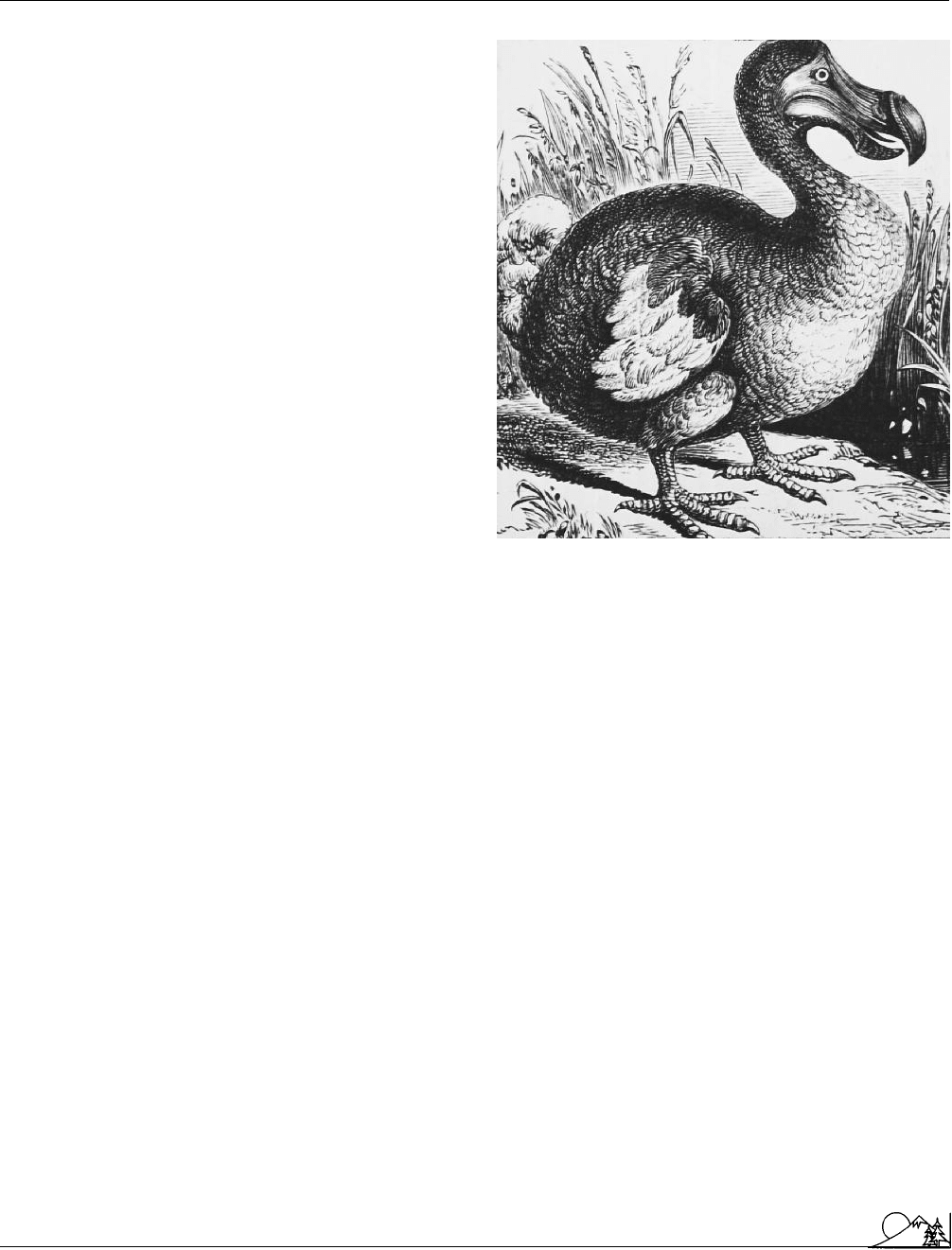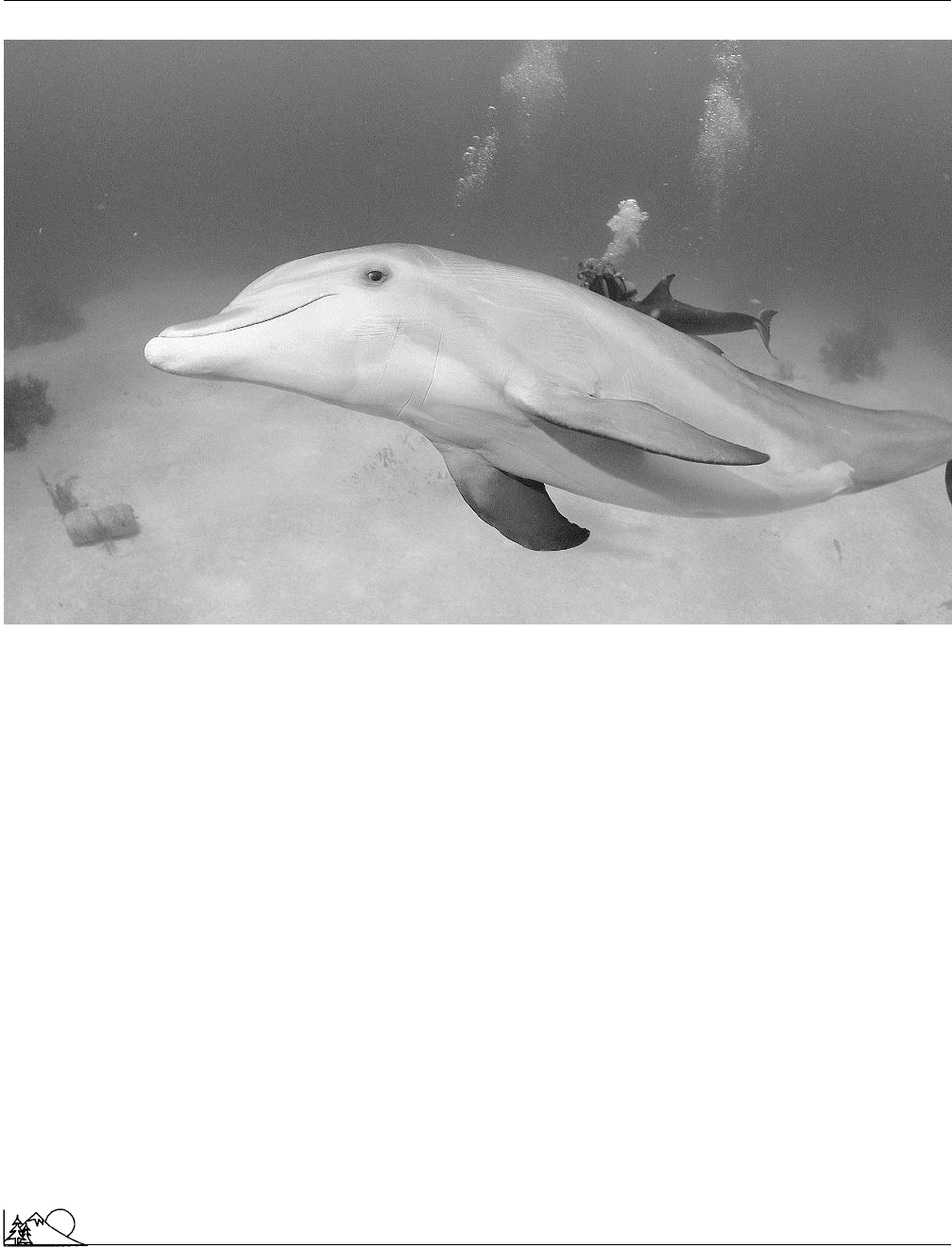Environmental Encyclopedia
Подождите немного. Документ загружается.


Environmental Encyclopedia 3
Detritivores
toxicity and an increase in water solubility, as well as provides
a reaction group that can be used in further transformation
processes such as conjugation. Microorganisms use a dioxy-
genase system, in which oxidation is accomplished by adding
both atoms of molecular oxygen to the double bond present
in various aromatic (containing benzene-like rings)
hydro-
carbons
.
Ring scission, or opening, of aromatic ring compounds
also can occur through oxidation. Though aromatic ring
compounds are usually stable in the environment, some mi-
croorganisms are able to open aromatic rings by oxidation.
After the aromatic rings are opened, the compounds may
be further degraded by other organisms or processes. The
number, type, and position of substituted molecules on the
aromatic ring may protect the ring from enzymatic attack
and may retard scission.
Photodecomposition can also result in the detoxifica-
tion of toxic chemicals in the
atmosphere
, in water, and
on the surface of solid materials such as plant leaves and soil
particles. The reaction is usually enhanced in the presence of
water; photodecomposition is also important in the detoxifi-
cation of evaporated compounds. The
ultraviolet radiation
in sunlight is responsible for most photodecomposition pro-
cesses. In photooxidation, for example, photons of light
provide the necessary energy to mediate the reactions with
oxygen to accomplish oxidation.
Combustion of toxic chemicals involves the oxidation
of compounds accompanied by a release of energy. Often
combustion does not completely result in the degradation
of chemicals, and may result in the production of very toxic
combustion products. However, if operating conditions are
properly controlled, combustion can result in the detoxifica-
tion of toxic chemicals.
Under
anaerobic
conditions, toxic compounds may
be detoxified enzymatically by reduction. An example of a
reductive detoxifying process is the removal of halogens from
halogenated compounds. Dehydrohalogenation is another
anaerobic process that also results in the removal of halogens
from compounds.
Hydrolysis is an important detoxification mechanism
in which water is added to the molecular structure of the
compound. The reaction can occur either enzymatically or
nonenzymatically. Hydration of toxic compounds occurs
when water is added enzymatically to the molecular structure
of the compound.
Conjugation reactions involve the combination of for-
eign toxic compounds with endogenous, or internal, com-
pounds to form conjugates that are water soluble and can
be eliminated from the biological organism. However, the
toxic compound may still be available for uptake by other
organisms in the environment. Endogenous compounds
367
used in the conjugation process include sugars, amino
acid
residues,
phosphates
, and sulfur compounds.
Many metals can be detoxified by forming complexes
with organic compounds by sharing electrons through the
process of chelation. These complexes may be insoluble or
nonavailable in the environment; thus the toxicant can not
affect the organism.
Sorption
of toxic compounds to solids
in the environment, such as soil particles, as well as incorpo-
ration into
humus
, may also result in detoxification of the
compounds.
Generally, the complete detoxification of a toxic com-
pound is dependent on a number of different chemical reac-
tions, both biological and non-biological, proceeding simul-
taneously, and involving the original compound as well as
the transformation products formed. See also Biogeochemical
cycles; Biomagnification; Chemical bond; Environmental
stress; Incineration; Oxidation reduction reaction; Persistent
compound; Water hyacinth
[Judith Sims]
R
ESOURCES
B
OOKS
Burnside, O. C. “Prevention and Detoxification of Pesticide Residues in
Soils.” In Pesticides in Soil and Water, edited by W. D. Guenzi. Madison,
WI: Soil Science Society of America, 1974.
Dauterman, W. C., and E. Hodgson. “Chemical Transformations and
Interactions.” In Introduction to Environmental Toxicology, edited by F. E.
Guthrie, and J. J. Perry. New York: Elsevier, 1980.
Rand, G. M. “Detection: Bioassay.” In Introduction to Environmental Toxi-
cology, edited by F. E. Guthrie, and J. J. Perry. New York: Elsevier, 1980.
Detritivores
Detritivores are organisms within an
ecosystem
that feed
on dead and decaying plant and animal material and waste
(called
detritus
); detritivores represent more than half of the
living
biomass
. Protozoa, polychaetes, nematodes, Fiddler
crabs, and filter-feeders are a few examples of detritivores
that live in the salt marsh ecosystem. (Fiddler crabs, for
instance, scoop up grains of sand and consume the small
particles of decaying organic material between the grains.)
While
microbes
would eventually decompose most material,
detritivores speed up the process by comminuting, and partly
digesting the dead, organic material. This allows the mi-
crobes to get at such material more readily. The continuing
decomposition
process is vital to the existence of an ecosys-
tem—essential in the maintenance of
nutrient
cycles, as well
as the natural renewal of
soil
fertility.

Environmental Encyclopedia 3
Detritus
Detritus
Detritus is dead and decaying matter including the wastes
of organisms. It is composed of organic material resulting
from the fragmentation and
decomposition
of plants and
animals after they die. Detritus is decomposed by bacterial
activity, which can help cycle nutrients back into the food
chain. In aquatic environments, detritus may make up a
substantial percentage of the
particulate
organic
carbon
(POC) that is suspended in the water column. Animals that
consume detritus are called “detritivores". Although detritus
is available in large quantities in most ecosystems, it is usually
not a very high quality food, and may be lacking in essential
nitrogen
or carbon compounds.
Detritivores
generally must
expend a larger amount of energy to assimilate carbon and
nutrients from detritus than from sources of food based on
living plant or animal material. Some detritivores harbor
beneficial bacteria or
fungi
in their guts to aid in the diges-
tion of compounds that are difficult to degrade.
[Marie H. Bundy]
Development, sustainable
see
Sustainable development
Dew point
An expression of humidity defined as the temperature to
which air must be cooled to cause condensation of its water
vapor content (dew formation) without the adding or sub-
tracting of water vapor or changing its pressure. At this
point the air is saturated and relative humidity becomes
100%. When the dew point temperature is below freezing
it is also referred to as the frost point. The dewpoint is a
conservative expression of humidity because it changes very
little across a wide range of temperature and pressure, unlike
relative humidity which changes with both. Dew points,
however, are affected by water vapor content in the air. High
dew points indicate large amounts of water vapor in the
air and low dew points indicate small amounts. Scientists
measure dew points in several ways: with a dew point hy-
grometer; from known temperature and relative humidity
values; or from the difference between dry and wet bulb
temperatures using tables. They use this measurement to
predict fog, frost, dew, and overnight minimum temperature.
Diapers
see
Disposable diapers
368
Diazinon
An
organophosphate pesticide
. Malathion and parathion
are other well-known organophosphate pesticides. The or-
ganophosphates inhibit the action of the
enzyme
cholines-
terase, a critical component of the chain by which messages
are passed from one nerve cell to the next. They are highly
effective against a wide range of pests. However, since they
tend to affect the human nervous system in the same way
they affect insects, they tend to be dangerous to humans,
wildlife
, and the
environment
. One of the most widely-
used lawn
chemicals
, diazinon has been implicated in killing
songbirds, pet dogs and cats, and causing near fatal poison-
ings in humans. The EPA banned its use on
golf courses
and sod farms after numerous reports of its killing ducks,
geese, and other birds. See also Cholinesterase inhibitor
Dichlorodiphenyl-trichloroethane
Dichlorodiphenyl-trichloroethane (DDT) can be degraded
to several stable breakdown products, such as DDE and
DDD. Usually DDT refers to the sum of all the DDT-
related components.
DDT was first developed for use as an insecticide in
Switzerland in 1939, and it was first used on a large scale
on the Allied troops in World War II. Commercial, non-
military use began in the United States in 1945. The discov-
ery of its insecticidal properties was considered to be one of
the great moments in public health disease control, as it was
found to be effective on the carriers of many leading causes
of death throughout the world including
malaria
, dysentery,
dengue fever, yellow fever, filariasis, encephalitis, typhus,
cholera
, and scabies. It could be sprayed to control mosqui-
toes and flies or applied directly in powder form to control
lice and ticks. It was considered the “atomic bomb” of pesti-
cides, as it benefited public health by direct control of more
than 50 diseases and enhanced the world’s food supply by
agricultural
pest
control. It had eliminated mosquito trans-
mission of malaria in the United States by 1953. In the first
10 years of its use, it was estimated to have saved five million
lives and prevented 100 million illnesses worldwide.
Use of DDT declined in the mid-1960s due to in-
creased
resistance
of different
species
of mosquitos and
flies and other pests, and to increasing concerns regarding
the potential harm to ecosystems and human health. Al-
though the potential hazard from dermal
absorption
is
small when the compound is in dry or powdered form, if
the compound is in oil or an organic solvent it is readily
absorbed through the skin and represents a considerable
hazard.

Environmental Encyclopedia 3
Die-off
Primarily DDT affects the central nervous system,
causing dizziness, hyperexcitability, nausea, headaches,
tremors, and seizures from acute exposure. Death can result
from respiratory failure. It also is a liver toxin, activating
microsomal
enzyme
systems and causing liver tumors. DDE
is of similar toxicity. It became the focus of much public
debate in the United States after the publication of Silent
Spring by Rachel Carson, who effectively dramatized the
harm to birds,
wildlife
, and possibly humans from the wide-
spread use of DDT. Extensive spraying programs to eradi-
cate Dutch elm disease and the
gypsy moth
(Porthetria
dispar) also caused widespread songbird
mortality
. Its accu-
mulation in the
food chain/web
also led to chronic expo-
sures to certain wildlife populations. Fish-eating birds were
subject to reproductive failure, due to egg shell thinning and
sterility. DDT is resistant to breakdown and is transported
long distances, making it ubiquitous in the world
environ-
ment
today. It was banned in the United States in 1972
after extensive government hearings, but is still in use in
other parts of the world, mostly in developing countries,
where it continues to be useful in the control of carrier-
borne diseases. See also Acute effects; Chronic effects; Detox-
ification
[Deborah L. Swackhammer]
R
ESOURCES
B
OOKS
Toxicology of Pesticides. Copenhagen, Denmark: World Health Organiza-
tion, 1982.
O
THER
DDT and Its Derivatives. Environmental Health Criteria 9. Geneva, Swit-
zerland: World Health Organization, 1979.
Dieback
Dieback refers to a rapid decrease in numbers experienced
by a population of organisms that has temporarily exceeded,
or overshot, its
carrying capacity
. Organisms at low trophic
levels such as rodents or deer, as well as weed
species
of
plants, experience dieback most often. Without pressure
from predators or other limiting factors, such “opportunistic”
species reproduce rapidly, consume food sources to deple-
tion, and then experience a population crash due chiefly to
starvation (though reproductive failure can also play a part
in dieback). The presence of predators—for instance, foxes
in a meadow inhabited by small rodents—often results in a
stabilizing effect on population numbers.
369
Die-off
Die-offs are the massive, sometimes unexplained but always
unexpected, disappearances of plants and animals. The most
well-known is probably the die-off of dinosaurs, but die-
offs continue today in many regions of the world, including
the United States.
Frogs
and their kin are mysteriously vanishing in some
areas, and scientists suspect that human alteration of ecosys-
tems is partly responsible. On five continents, scientists in 19
countries have reported massive die-offs among amphibians.
Frogs are good indicators of environmental change because
of the permeability of their skin. They are extremely suscepti-
ble to toxic substances on land and in water. Decreasing
rainfall in some areas may be a factor in the die-offs, as is
habitat
loss due to
wetlands drainage
. Other scientists
are investigating whether increased
ultraviolet radiation
due to
ozone
depletion is killing toads in the Cascade
Mountain Range.
Other multiple factors—such as
acid rain
, heavy metal
and
pesticide
contamination of ponds and other surface
water, and human predation in some areas—may be causing
the amphibians to die off. In France, for example, thousands
of tons of frog legs imported from Bangladesh and Indonesia
are consumed each year.
Scientists also have recorded widespread declines in
the numbers of migratory songbirds in the Western Hemi-
sphere and of wild mushrooms in Europe. The decline in
these so-called indicator organisms is a sign of declining
health of the overall ecosystems.
The decline of songbirds is attributed to the loss or
fragmentation of habitat, particularly forests, throughout the
songbirds’ range from Canada to Central America and
northern South America.
Fungi
populations in Europe are
dying off, and scientists think it is more than a problem of
overharvesting. The health of forests in Europe is closely
linked to the fungi populations, which point to the ecological
decline of the forests. Some scientists believe that
air pollu-
tion
is also playing a role in their decline.
A massive die-off of millions of starfish in the White
Sea has been attributed to radioactive military waste in the
former Soviet Union. French scientists have recorded grow-
ing numbers of dead
dolphins
along the Riviera, probably
due to
environmental stress
which left the animals too
weak to fight off a
virus
.
[Linda Rehkopf]
R
ESOURCES
B
OOKS
Gore, Al. Earth in the Balance. New York: Houghton Mifflin, 1992.

Environmental Encyclopedia 3
Annie Dillard
P
ERIODICALS
“Earth Almanac: Why Are Frogs and Toads Knee-Deep in Trouble?”
National Geographic 183 (April 1993).
Digester
see
Wastewater
Annie Dillard (1945 – )
American writer
Often compared to the American naturalist
Henry David
Thoreau
, Dillard—a novelist, memoir writer, essayist, poet,
and author of books about the natural world—is best known
for her acute observation of the land, the seasons, the chang-
ing weather, and the
wildlife
within her intensely seen
envi-
ronment
. Though born in Pittsburgh, Pennsylvania on April
30, 1945, Dillard’s vision of nature’s violence and beauty
was most fully developed living in Virginia, where she re-
ceived her B.A., 1967, and M.A., 1968, from Hollins Col-
lege. She also lived in the Pacific Northwest from 1975–
1979 as scholar-in-residence at the University of Western
Washington, in Bellingham, and is adjunct professor of En-
glish and writer in residence at Wesleyan University, in
Middletown, Connecticut, where she lives with her husband,
Bob Richardson, and her daughter, Rosie. Since 1973, she
has also been a columnist for The Living Wilderness, the
magazine of the
Wilderness Society
, the leading organiza-
tion advocating expansion of the nation’s wilderness.
In 1975, Dillard won the Pulitzer Prize for general
nonfiction for her first book of prose, Pilgrim at Tinker
Creek (1974), subtitled “A mystical excursion into the natural
world,” in which she presented—quoting Henry David Tho-
reau—"a meteorological journal of the mind” based on her
life in the Roanoke Valley, Virginia, where she had lived
since 1965. Her vision of “power and beauty, grace tangled
in a rapture of violence,” of a world in which “carnivorous
animals devour their prey alive,” is also an intense celebration
of the things seen as she wanders the Blue Ridge mountain-
side, the Roanoke creek banks, observing muskrat, deer, red-
winged blackbirds, and the multitude of “free surprises” her
environment unexpectedly, and fleetingly, displays. Seeing
acquires a mystical primacy in Dillard’s work.
The urgency of seeing is also conveyed in Dillard’s
only book of essays, Teaching A Stone To Talk (1982), in
which she writes: “At a certain point you say to the woods,
to the sea, to the mountains, the world, Now I am ready.
Now I will stop and be wholly attentive.” Dillard suggests
that, for the natural phenomena that we do not use or eat,
our only task is to witness. But in witnessing, she sees cruelty
and suffering, making her question at a religious level what
370
mystery lies at the heart of the created universe, of which
she writes: “The world has signed a pact with the devil...The
terms are clear: if you want to live, you have to die.”
Unlike some natural historians or writers of environ-
mental books, Dillard is not associated with a specific pro-
gram for curbing the destructiveness of human civilization.
Rather, what has been described as her loving attentiveness
to the phenomenal world—"nature seen so clear and hard
that the eyes tear,” as one reviewer commented—allies her
with the broader movement of writers whose works teach
some other relationship to
nature
than exploitation. In Holy
the Firm (1977), her 76-page journal of several days spent
in Northern Puget Sound, Dillard records such events as
the burning of a seven-year-old girl in a plane crash and a
moth’s immolation in a candle flame to rehearse her theme
of life’s harshness, but at the same time, to note, “A hundred
times through the fields and along the deep roads I’ve cried
Holy.” In the end, Dillard is a sojourner, a pilgrim, wander-
ing the world, ecstatically attentive to nature’s bloodiness
and its beauty.
The popularity of Dillard’s writing during the late
1980s and 1990s can be judged by the frequency with which
her work was reprinted during these decades. As well as
excerpts included in multi-author collections, the four-vol-
ume Annie Dillard Library appeared in 1989, followed by
Three by Annie Dillard (1990), and The Annie Dillard Reader
(1994). During these years, she also served as the co-editor
of two volumes of prose—The Best American Essays (1988),
with Robert Atwan, and Modern American Memoirs (1995),
with Cort Conley—and crafted Mornings Like This: Found
Poems (1995), a collection of excerpts from other writers’
prose, which she reformatted into verse.
Though a minor work, Mornings Like This could be
said to encapsulate all of the qualities that have made Dil-
lard’s work consistently popular among readers: clever and
playful, it displays her wide learning and eclectic tastes, her
interest in the intersection of nature and science with history
and art, and her desire to create beauty and unity out of the
lost and neglected fragments of human experience.
[David Clarke]
R
ESOURCES
B
OOKS
Dillard, Annie. An American Childhood. New York: Harper and Row, 1987.
———. Encounters With Chinese Writers. Connecticut: Wesleyan University
Press, 1984.
———. Holy the Firm. New York: Harper & Row Publishers, 1982.
———. The Living. New York: Harper Collins, 1992.
———. Pilgrim at Tinker Creek. New York: Bantam Books, Inc., 1975.
———. Teaching A Stone To Talk: Expeditions and Encounters. New York:
Harper & Row Publishers, 1982.

Environmental Encyclopedia 3
Dioxin
Johnson, Sandra Humble. The Space Between: Literary Epiphany in the Work
of Annie Dillard. Kent, OH: Kent State University Press, 1992.
Parrish, Nancy C. Lee Smith, Annie Dillard, and the Hollins Group: A Genesis
of Writers. Baton Rouge: Louisiana State University Press, 1998.
Smith, Linda L. Annie Dillard. Boston: Twayne, 1991.
———. The Annie Dillard Reader. New York: HarperCollins, 1994.
Dioxin
Dioxin is the chemical byproduct of certain manufacturing
processes or products. It develops during the manufacture
of two herbicides known as
2,4,5-T
and
2,4-D
, which are
the two components found in
Agent Orange
. Dioxin is
also manufactured in several other chemical processes, in-
cluding the chlorinated bleaching of pulp and paper. The
issue of dioxin’s toxicity is one of the most hotly debated in
the scientific community, involving the federal government,
industry, the press, and the general public.
While dioxin commonly refers to a particular com-
pound known as tetrachlorodibenzo-p-dioxin, or TCDD,
there are actually 75 different dioxins. TCDD has been
studied in some manner since the 1940s, and the most recent
information indicates that it is capable of interfering with
a number of physiological systems. Its toxicity has been
compared to
plutonium
and it has proven lethal to a variety
of research animals, including guinea pigs, monkeys, rats,
and rabbits.
TCDD is also the chemical that some scientists at
the
Environmental Protection Agency
(EPA) and a broad
spectrum of researchers have called the most carcinogenic
ever studied. During the late 1980s and early 1990s, it was
linked to an increased risk of rare forms of
cancer
in hu-
mans—especially soft tissue sarcoma and non-Hodgkins
lymphoma—at very high doses. Some have called dioxin
“the most toxic chemical known to man.” According to
Barry Commoner
, Director of the Center for the Biology
of Natural Systems at Washington University, the chemical
is “so potent a killer that just three ounces of it placed in
New York City’s water supply could wipe out the populace.”
Exposure can come from a number of sources. Dioxin
can be air-borne and inhaled in drifting incinerator ash,
aerial spraying, or the hand spray application of weed killers.
Dioxin can be absorbed through the skin as people walk
through a recently sprayed area such as a backyard or a golf
course. Water
runoff
and
leaching
from agricultural lands
treated with pesticides can pollute lakes, rivers, and under-
ground aquifers. Thus, dioxin can be ingested in contami-
nated water, in fish, and in beef that has grazed on sprayed
lands. Residues in plants consumed by animals and humans
add to the contaminated
food chain/web
. Research has
shown that nursing children now receive trace amounts of
dioxin in their mother’s milk.
371
Because it bioaccumulates in the
environment
,
TCDD continues to be found in the
soil
and waterways in
microscopic quantities over 25 years after its first application.
Dioxin is part of a growing family of
chemicals
known as
organochlorines—a class of chemicals in which
chlorine
is bonded with
carbon
. These chlorinated substances are
created to make a number of products such as
polyvinyl
chloride
, solvents, and refrigerants as well as pesticides.
Hundreds or thousands of organochlorines are produced as
by-products when chlorine is used in the bleaching of pulp
and paper or the disinfection of
wastewater
and when
chlorinated chemicals are manufactured or incinerated. The
by-products of these processes are toxic, persistent, and hor-
monally active. TCDD is also part of current manufacturing
processes, such as the manufacture of the wood preservative,
pentachlorophenol
.
If the exposure to dioxin is intense, there can be an
immediate response. Tears and watery nasal
discharge
have
been reported, as have intense weakness, giddiness, vomiting,
diarrhea, headaches, burning of the skin, and rapid heartbeat.
Usually, a weakness persists and a severe skin eruption known
as chloracne develops after a period of time. The body ex-
cretes very little dioxin, and the chemical can accumulate in
the body fat after exposure. Minute quantities may be found
in the body years after modest exposure. Since TCDD’s
half-life
has been estimated at as much as 10–12 years in
the soil, it is possible that some TCDD—suggested to be
as much as seven
parts per trillion
(ppt)—is harbored in
the bodies of most Americans.
The development of medical problems may appear
shortly after exposure, or they may appear 10, 12, or 20 years
later. If the exposure is large, the symptoms develop more
quickly, but there is a greater
latency
period for smaller
exposures. This fact explains why humans exposed to TCDD
may appear healthy for years before finally showing what
many consider to be typical dioxin-exposure symptoms, such
as cancer or immune system dysfunction. There is also a
relationship between toxicology and individual susceptibility.
Certain people are more susceptible to the effects of dioxin
exposure than others. Once a person has become susceptible
to the chemical, he or she tends to develop cross reactions to
other materials that would not normally trigger any response.
Government publications and research funded by the
chemical industry have questioned the relationship between
dioxin exposure and many of these symptoms. But a growing
number of private physicians treating people exposed to
dioxins have become increasingly certain about patterns or
clusters of symptoms. They have reported a higher incidence
of cancer at sites of industrial accidents, including increases
in rates of stomach cancer, lung cancer, soft-tissue sarcomas,
and malignant lymphomas. Some reports have indicated
that soft-tissue sarcomas in dioxin-exposed workers have

Environmental Encyclopedia 3
Discharge
increased by a factor of 40, and there have also been indica-
tions of psychological and personality changes and an excess
of coronary disease.
Many theories about the medical effects of dioxin ex-
posure are based on the case histories of the thousands of
American military personnel exposed to Agent Orange dur-
ing the Vietnam War. Agent Orange, a chemical defoliant,
was used despite the fact that certain chemical companies
and select members of the military knew about its toxic
properties. Thousands of American ground troops were di-
rectly sprayed with the chemical. Those in the spraying
planes inhaled the chemical directly when some of the herbi-
cides were blown back by the wind into the open doors of
their planes. Others were exposed to accidental dumpings
from the sky, when planes in trouble had to evacuate their
loads during emergency procedures.
Despite what many consider to be the obvious dangers
of dioxin, industries continue to produce residues and market
products contaminated with the chemical. White bleached
paper goods contain quantities of TCDD because no agency
has required the paper industry to change its bleaching pro-
cess. Women use dioxin-tainted, bleached tampons, and
infants wear bleached, dioxin-tainted paper diapers. Some
scientists have estimated that every person in the United
States carries a body burden of dioxin that may already be
unacceptable.
Many believe that the EPA has done less to regulate
dioxin than it has done for almost any other
toxic sub-
stance
. Environmentalists and other activists have argued
that any other chemical creating equivalent clusters of prob-
lems within specific groups of similarly exposed victims
would be considered an epidemic. Industry experts have
often downplayed the problems of dioxin. A spokesman for
Dow Chemical has stated that “outside of chloracne, no
medical evidence exists to link up dioxin exposure to any
medical problems.” The federal government and federal
agencies have also been accused of protecting their own
interests. During congressional hearings in 1989 and 1990,
the Centers for Disease Control was found to falsify
epide-
miology
studies on Vietnam veterans.
In April 1991, the EPA initiated a series of studies
intended to revise their estimate of dioxin’s toxicity. The
agency believed there was new scientific evidence worth
considering. Several industries, particularly the paper indus-
try, had also pressured the agency to initiate the studies, in
the hope that public fears about dioxin toxicity could be
allayed. But the first draft of the revised studies, issued
in the summer of 1992, indicated more rather than fewer
problems with dioxin. It appears to be the most damaging
to animals exposed while still in the uterus. It also seems to
affect behavior and learning ability, which suggests that it
372
may be a
neurotoxin
. These studies have also noted the
possibility of extensive effects on the immune system.
Other studies have established that dioxin functions
like a steroid hormone. Steroid hormones are powerful
chemicals that enter cells, bind to a receptor or protein, form
a complex that then attaches to the cell’s chromosomes,
turning on and off chemical switches that may then affect
distant parts of the body. It is not unusual for very small
amounts of a steroid hormone to have major effects on
the body. Newer studies conducted on
wildlife
around the
Great Lakes
have shown that dioxin has the capacity to
feminize male chicks and rats and masculinize female chicks
and rats. In male animals, testicle size is reduced as is sperm
count.
It is likely that dioxin will remain a subject of consider-
able controversy both in the public realm and in the scientific
community for some time to come. However, even those
scientists who question dioxin’s long-term toxic effect on
humans, agree that the chemical is highly toxic to experimen-
tal animals. Dioxin researcher Nancy I. Kerkvliet of Oregon
State University in Corvallis characterizes the situation in
these terms, “The fact that you can’t clearly show the effects
in humans in no way lessens the fact that dioxin is an
extremely potent chemical in animals—potent in terms of
immunotoxicity, potent in terms of promoting cancer.” See
also Bioaccumulation; Hazardous waste; Kepone; Organ-
ochloride; Pesticide residue; Pulp and paper mills; Seveso,
Italy; Times Beach, Missouri
[Liane Clorfene Casten]
R
ESOURCES
B
OOKS
Husar, R. B. Biological Basis for Risk Assessment of Dioxins and Related
Compounds. Cold Spring Harbor, NY: Cold Spring Harbor Laboratory
Press, 1991.
P
ERIODICALS
“German Dioxin Study Indicates Increased Risk.” BioScience 42 (February
1992): 151.
Gough, M. “Agent Orange: Exposure and Policy.” American Journal of
Public Health 81 (March 1991): 289-90.
Schmidt, K. F. “Dioxin’s Other Face: Portrait of an ’Environmental Hor-
mone’.” Science News 141 (11 January 1992): 24-7.
Tschirley, F. “Dioxin.” Scientific American 254 (February 1986): 29-35.
Zumwalt, Admiral Elmo R. Jr. USN (Ret.) “Report to the Secretary of
Veterans Affairs, The Hon. Edward J. Derwinski. From the Special Assis-
tant: Agent Orange Issues.” First Report, May 5, 1990.
Discharge
A term generally used to describe the release of a gas, liquid,
or solid to a treatment facility or the
environment
. For

Environmental Encyclopedia 3
Dissolved solids
example,
wastewater
may be discharged to a sewer or into
a stream, and gas may be discharged into the
atmosphere
.
Disposable diapers
Disposable diapers were introduced by Procter & Gamble
in 1961. First used as an occasional convenient substitute
for cloth diapers, their popularity has since exploded. By
1990 they were the primary diapering method for 85% of
American parents. As a result, 2.7 million tons of disposable
diapers are discarded every year, a point decried by environ-
mentalists.
Proponents of reusables argue that this accounts for
only two to three% of America’s
solid waste
. Although
detailed studies have examined the influence of both kinds
of diapers on such variables as water consumption,
water
pollution
, energy consumption,
air pollution
, and waste
generation, there are no indisputable conclusions about
which choice is better for the
environment
. Each study
was based on different assumptions and came to different
conclusions. Most were commissioned by either the dispos-
able-diaper or reusable-diaper industry, and each side put
their respective diapers slightly ahead of the other’s.
Disposable diapers and their packaging create more
solid waste than reusables, and because they are used only
once, consume more raw materials—petrochemicals and
wood pulp—in their manufacture. And although disposable
diapers should be emptied into the toilet before the diapers
are thrown away, many people skip this step, which puts feces
(that may be contaminated with pathogens) into landfills
and incinerators. There is no indication, however, that this
practice has resulted in any increase in health problems. But
cloth diapers affect the environment as well. They are made
of cotton, which is watered with
irrigation
systems and
treated with synthetic fertilizers and pesticides. They are
laundered and dried up to 78 (commercial) or 180 (home)
times, consuming more water and energy than disposables.
In fact, home laundering is less energy efficient than com-
mercial because it is done on a smaller scale. Diaper services
make deliveries in trucks, which expends another measure
of energy and generates more
pollution
. Human waste from
cotton diapers is treated in sewer systems. Some disposable
diapers are advertised as
biodegradable
and claim to pose
less of a solid-waste problem than regular disposables. Their
waterproof cover contains a cornstarch derivative that de-
composes into water and
carbon dioxide
when exposed to
water and air. Unfortunately, modern landfills are airtight
and little, if any, degradation occurs. Biodegradable diapers,
373
therefore, are not significantly different from other dispos-
ables.
[Teresa C. Donkin]
R
ESOURCES
P
ERIODICALS
Poore, P. “Disposable Diapers Are OK.” Garbage 4 (October-November
1992): 26-8+.
Raloff, J. “Reassessing Costs of Keeping Baby Dry [Cloth vs. Disposable].”
Science News 138 (1 December 1990): 347.
Rathje, W., and C. Murphy. “Cotton vs. Disposables: What’s the Damage.”
Garbage 4 (October-November 1992): 29-30.
O
THER
Lehrburger, C., J. Mullen, and C. V. Jones. Diapers: Environmental Impacts
and Lifecycle Analysis (Summary). Report to the National Association of
Diaper Services, Philadelphia, PA. January 1991.
Dissolved oxygen
Dissolved oxygen (DO) refers to the amount of oxygen
dissolved in water and is particularly important in
limnology
(aquatic
ecology
). Oxygen comprises approximately 21% of
the total gas in the
atmosphere
; however, it is much less
available in water. The amount of oxygen water can hold
depends upon temperature (more oxygen can be dissolved
in colder water), pressure (more oxygen can be dissolved in
water at greater pressure), and
salinity
(more oxygen can
be dissolved in water of lower salinity). Many lakes and
ponds have anoxic (oxygen deficient) bottom layers in the
summer because of
decomposition
processes depleting the
oxygen. The amount of dissolved oxygen often determines
the number and types of organisms living in that body of
water. For example, fish like trout are sensitive to low DO
levels (less than eight
parts per million
) and cannot survive
in warm, slow-moving streams or rivers. Decay of organic
material in water caused by either chemical processes or
microbial action on untreated sewage or dead vegetation can
severely reduce dissolved oxygen concentration. This is the
most common cause of
fish kills
, especially in summer
months when warm water holds less oxygen anyway.
Dissolved solids
Dissolved solids are minerals in solution, typically measured
in
parts per million
(ppm) using an electrical conductance
meter calibrated to oven-dried samples. In humid regions,
dissolved solids are often the dominant form of
sediment
transport. Solution features such as caverns and
sinkholes
are common in limestone regions.
Water that contains excessive amounts of dissolved
solids is unfit for drinking. Drinking water standards typi-

Environmental Encyclopedia 3
Dodo
cally allow a maximum of 250 ppm, the threshold for tasting
sodium chloride; by comparison, ocean water ranges from
33,000–37,000 ppm.
Phosphates
and
nitrates
in solution
are the major cause of eutrophication (
nutrient
enrichment
resulting in excessive growth of algae). Dissolved solids
buffer acid
precipitation; lakes with low levels are especially
vulnerable. High levels occur in
runoff
from newly-disturbed
landscapes, such as strip mines and road construction.
Diversity
see
Biodiversity
DNA
see
Deoxyribose nucleic acid
Dodo
One of the best known extinct
species
, the dodo (Raphus
cucullatus), a flightless bird native to the Indian Ocean island
of Mauritius, disappeared around 1680. A member of the
dove or pigeon family, and about the size of a large turkey,
the dodo was a grayish white bird with a huge black-and-
red beak, short legs, and small wings. The dodo did not
have natural enemies until humans discovered the island in
the early sixteenth century.
The dodo became extinct due to
hunting
by European
sailors who collected the birds for food and to predation of
eggs and chicks by introduced dogs, cats, pigs, monkeys,
and rats. The Portuguese are credited with discovering Mau-
ritius, where they found a tropical paradise with a unique
collection of strange and colorful birds unafraid of humans:
parrots and parakeets
, pink and blue pigeons, owls, swal-
lows, thrushes, hawks, sparrows, crows, and dodos. Unwary
of predators, the birds would walk right up to human visitors,
making themselves easy prey for sailors hungry for food
and sport.
The Dutch followed the Portuguese and made the
island a Dutch possession in 1598 after which Mauritius
became a regular stopover for ships traversing the Indian
Ocean. The dodos were subjected to regular slaughter by
sailors, but the species managed to breed and survive on the
remote areas of the island.
When the island became a Dutch colony in 1644,
the colonists engaged in a seemingly conscious attempt to
eradicate the birds, despite the fact that they were not pests
or obstructive to human living. But they were easy to kill.
The few dodos in inaccessible areas that could not be found
by the colonists were eliminated by the animals introduced
374
The dodo from Mauritius became extinct during
the seventeenth century. (Illustration by George Ber-
nard, Science Photo Library. Photo Researchers Inc. Repro-
duced by permission.)
by the settlers. By 1680, the last remnant survivors of the
species were “as dead as a dodo.”
Interestingly, while the dodo tree (Calvaria major)
was once common on Mauritius, the tree seemed to stop
reproducing after the dodo disappeared, and the only re-
maining specimens are about 300 years old. Apparently, a
symbiotic relationship existed between the birds and the
plants. The fruit of this tree was an important food source
for the dodo. When the bird ate the fruit, the hard casing
of the seed was crushed, allowing it to germinate when
expelled by the dodo.
Three other related species of giant, flightless doves
were also wiped out on nearby islands. The white dodo
(Victoriornis imperialis) inhabited Reunion, 100 mi (161 km)
southwest of Mauritius, and seems to have survived up to
around 1770. The Reunion solitaire (Ornithoptera solitarius)
was favored by humans for eating and was hunted to
extinc-
tion
by about 1700. The “delightfully beautiful” Rodriguez
solitaire (Pezophaps solitarius), found on the island of Rodri-
guez 300 mi (483 km) east of Mauritius, was also widely
hunted for food and disappeared by about 1780.
[Lewis G. Regenstein]

Environmental Encyclopedia 3
Dolphins
A playful bottlenosed dolphin. (Photograph by Stephen Frink. Corbis-Bettmann. Reproduced by permission.)
R
ESOURCES
B
OOKS
Day, David. The Doomsday Book of Animals. New York: Viking, 1981.
The Dodo. Philadelphia: Wildlife Preservation Trust International, 1985.
Dolphins
There are 32
species
of dolphins, members of the cetacean
family Delphinidae, that are distributed in all of the oceans
of the world. These marine mammals are usually found in
relatively shallow waters of coastal zones, but some may be
found in open ocean. Dolphins are a relatively modern group;
they evolved about 10 million years ago during the late
Miocene. The Delphinidae represents the most diverse
group, as well as the most abundant, of all cetaceans. Among
the delphinids are the bottlenose dolphins (Tursiops trunca-
tus), best known for their performances in oceanaria; the
spinner dolphin (Stenella longirostris), which have had their
numbers decline due to tuna fishermen’s nets; and the orca
or the killer whale (Orcinus orca), the largest of the dolphins.
Dolphins are distinguished from their close relatives, the
porpoises, by the presence of a beak.
375
Dolphins are intelligent, social creatures, and social
structure is variously exhibited in dolphins. Inshore species
usually form small herds of two to 12 individuals. Dolphins
of more open waters have herds comprised of up to 1,000
or more individuals. Dolphins communicate by means of
echolocation, ranging from a series of clicks to ultrasonic
sounds, which may also be used to stun its prey. By acting
cooperatively, dolphins can locate and herd their food using
this ability. Aggregations of dolphins also have a negative
aspect, however. Mass strandings of dolphins, a behavior in
which whole herds beach themselves and die en mass,isa
well-known phenomenon but little understood by biologists.
Theories for this seemingly suicidal behavior include nema-
tode parasite infections of the inner ears, which upsets their
balance, orientation, or echolocation abilities; simple disori-
entation due to unfamiliar waters; or even perhaps magnetic
disturbances.
Because of their tendency to congregate in large herds,
particularly in feeding areas, dolphins have become vulnera-
ble to large nets of commercial fishermen.
Gill nets
, laid
down to catch oceanic
salmon
and capelin, also catch nu-
merous non-target species, including dolphins and inshore

Environmental Encyclopedia 3
Dominance
species of porpoises. In the eastern Pacific Ocean, especially
during the 1960s and 1970s, dolphins have been trapped
and drowned in the purse seines of the tuna fishing fleets.
This industry was responsible for the deaths of an average
of 113,000 dolphins annually and in 1974 alone, killed over
half a million dolphins in their nets. Tuna fishermen have
recently adopted special nets and different fishing procedures
to protect the dolphins. A panel of netting with a finer mesh,
the Medina panel, is part of the net furthest from the fishing
vessel. Inflatable power boats herd the tuna as the net is
pulled under and around the school of fish. As the net is
pulled toward the vessel many dolphins are able to escape
by jumping over the floats of the Medina panel, but others
are assisted by hand from the inflatable boats or by divers.
The finer mesh prevents the dolphins from getting tangled
in the net, unlike the large mesh which previously snared
the dolphins as they sought escape. Consumer pressure and
tuna boycotts were major factors behind this shift in tech-
niques on the part of the tuna fishing industry. To advertise
this new method of tuna fishing and to try to regain con-
sumer confidence, the tuna fishing industry has begun label-
ing their products “dolphin safe.” This campaign has been
successful in that slumping sales from the boycotts have
picked up over the last few years.
[Eugene C. Beckham]
R
ESOURCES
B
OOKS
Dolphins, Porpoises and Whales of the World. Gland, Switzerland, IUCN—
The World Conservation Union, 1991.
Evans, P. The Natural History of Whales & Dolphins. New York: Facts on
File, 1987.
Dominance
Dominance is an ecological term that refers to the degree
that a particular
species
is prevalent within its community,
in terms of its relative size, productivity, or cover. Because
of their ability to appropriate space, nutrients, and other
resources, dominant species have a relatively strong or con-
trolling influence on the structure and functions of their
community, and on the fitness and productivity of other
species. Ecological communities are often characterized on
the basis of their dominant species.
Species may become dominant within their commu-
nity if they are particularly competitive, that is, if they are
relatively successful under conditions in which the availabil-
ity of resources constrains
ecological productivity
and com-
munity structure. As such, competitive species are relatively
efficient at obtaining resources. For example, competitive
terrestrial plants are relatively efficient at accessing nutrients,
376
moisture, and space, and they are capable of regenerating
beneath their own shade. These highly competitive species
can become naturally dominant within their communities.
Many ecological successions are characterized by rela-
tively species-rich communities in the initial stages of recov-
ery after disturbance, followed by the development of less-
diverse communities as the most competitive species exert
their dominance. In such cases, disturbance can be an impor-
tant influence that prevents the most competitive species
from dominating their community. Disturbance can play
this role in two ways: (1) through relatively extensive, or
stand-replacing disturbances that set larger areas back to
earlier stages of
succession
, allowing species-rich communi-
ties to occupy the site for some time, or (2) by relatively
local disturbances that create gaps within late-successional
stands, allowing species-rich micro-successions to increase
the amount of diversity within the larger community.
Some natural examples of species-poor, late-succes-
sional communities that are dominated by only a few species
include the following: (1) the rocky intertidal of temperate
oceans, where mussels (e.g., Mytilus edulis) may occupy virtu-
ally all available substrate and thereby exclude most other
species, (2) eastern temperate forests of North America,
where species such as sugar maple (Acer saccharum) and east-
ern hemlock (Tsuga canadensis) are capable of forming pure
stands that exclude most other species of trees, and (3) a
few types of tropical rain forests, such as some areas of
Sumatra and Borneo where ironwood (Eusideroxylon zwag-
eri) can dominate stands. In the absence of either stand-
replacing disturbances or microdisturbances in these sorts of
late-successional ecosystems, extensive areas would become
covered by relatively simple communities dominated by these
highly competitive species.
Humans often manage ecosystems to favor the domi-
nance of one or several species that are economically favored
because they are crops grown for food, fibre, or some other
purpose. Some examples include: (1) cornfields, in which
dominance by Zea mays is achieved by plowing,
herbicide
application, insecticide use, and other practices, in order to
ensure that few plants other than maize are present, and
that the crop species is not unduly threatened by pests or
diseases; (2) forestry plantations, in which dominance by the
crop species is ensured by planting, herbicide application,
and other practices; and (3) grazing lands for domestic cattle,
whose dominance may be ensured by fencing lands to prevent
wild herbivores from utilizing the available forage, and by
shooting native herbivores and predators of cattle. In all of
the above cases, continued management of the
ecosystem
by humans is needed to maintain the dominance of the crop
species. Otherwise, natural ecological forces would result in
diminished dominance or even exclusion of the crop species.
